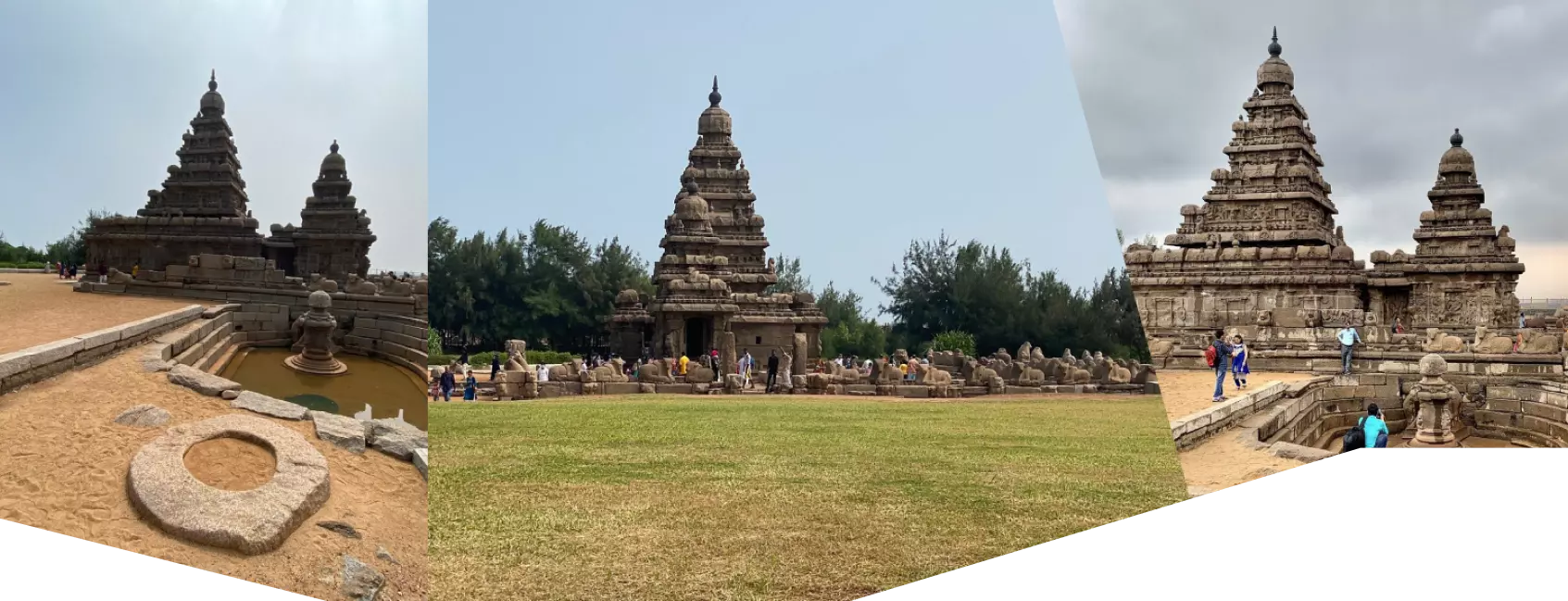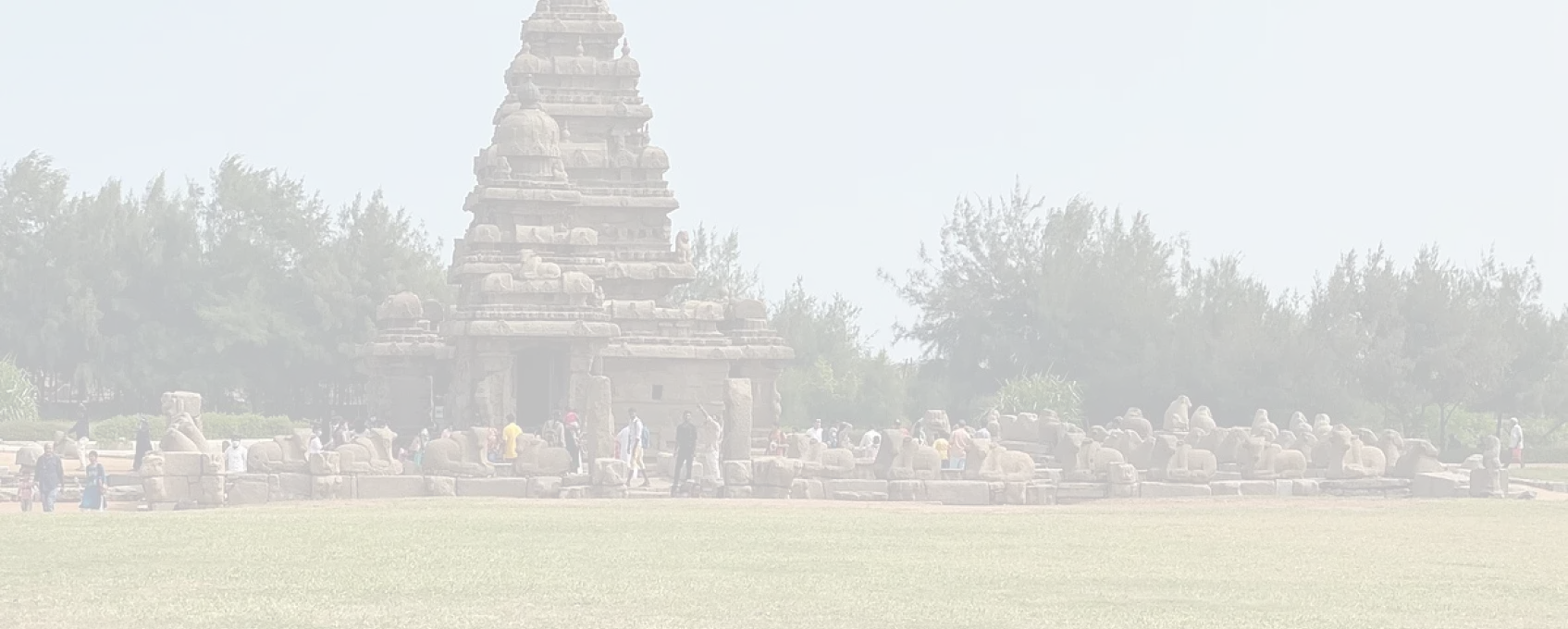
Location: Mahabalipuram, Tamil Nadu
Built by: Pallava king Narasimhavarman I
Built in the Year: 7th-Century
Architectural style: Dravidian style
Timings: 6 am to 6 pm
Entry Fee: Rs. 10 for locals, Rs. 340 for foreigners
‘’One of the oldest temples in South India, the Shore Temple is a magnificent historical grandeur showcasing the craftsmanship of the skillful workers through its architecture and intricate work. Belonging to the later half of the 7th century, the temple was built with cut-out granite blocks of rock. Nestled overlooking the shore of the Bay of Bengal in Mahabalipuram in Tamil Nadu, the temple gets its name because of its geographical location. Famous for its unique architecture and the ages it has been in existence in, the temple is one of the many ‘’heritage sites’’ in the world as classified by UNESCO. Believed to have been constructed by King Rajasimha, Shore Temple is a fine specimen of the first stage of the structural temples built in the Dravidian style of architecture. The temple has two main shrines dedicated to Lord Shiva and Lord Vishnu facing the east and the west and its architecture influenced the Cholas who succeeded the Pallavas as the dominant dynasty in the area now covered by Tamil Nadu.
Located in the ancient city of Mahabalipuram, earlier known as Mamallapuram which meant the city of Mamalla – the warrior, the title given to the Pallava king Narasimhavarman I (639-70 CE). Many of the structures that grace the land of Mahabalipuram today have been built during the reign of the Pallava king Narasimhavarman I. Mahabalipuram was an important port and a hub of trade during the ancient and early medieval India, with connections to Sri Lanka, China, and other South-East Asian countries. Among the most prominent attractions that made the thriving seaport of Mahabalipuram even more attractive is the Shore Temple. The temple has its description in many memoirs wrote by travelers and traders from across the world.
Marco Polo in his travel book described Shore Temple as the Seven Pagodas of Mamallapuram, a name which got glued to the collection of the Shore Temples among the traders and cartographers. Many different medieval European travelers have mentioned shore temples as seven of them, but at present only two of them are existing. After the tsunami of 2004, many sculptures, inscriptions, and parts of rock-cut temples receded to the shore and the deep-sea exploration revealed that there were more than two shore temples.
The Shore Temple stayed buried deep inside the sand until a few decades ago which was then discovered by the excavation team. While the sand had been withdrawn, the temple and its structure are still in danger with the sea right beside it and the relentless salt-laden winds and water spray posing a threat to the temple. The government has built a wall surrounding the temple and planted Casuarina trees to prevent further destruction.

The Shore Temple is dedicated to the worship Lord Shiva and Lord Vishnu and the oldest temple of structural significance in South India. The first thing that draws the attention of a visitor who sees the temple from a distance is the low prakara (wall) with couchant Nandis on it, an the tall pyramidal shikharas with the octagonal domes on top. The two tall shikharas/vimana have battered embellishment that have some similarities with the PanchRatha, however, unlike PanchRatha, these pinnacles have finials on top marking them as well-designed temples. The entry porches, that are the mandapas, have stairs leading to them and beyond the doorways that hold weathered dwarpala, are the two main sanctums. The sanctum demonstrates the typical Pallavan features comprising a Somskanda panel and a fluted Shiva ling (the smaller west facing sanctum has a missing ling while the east facing sanctum has a broken grooved ling). There is a third sanctum that stands behind the two main sanctums which has no vimana and holds a small mandapa and porch along with an established idol of Seshasayi (Sthalasayana) Vishnu in its sanctum. These five-storied temples have been structured in such a manner that the first glimmers of the sun kiss the main east-facing fluted lingam and light up the entire sanctum.
The outer walls of the temples are adorned with patterns of Simha-yalis, though they are mostly weathered beyond recognition now, owing to the corrosive salt-laden winds that have been attacking the temple for centuries. Towards the northern area of the temple there lies a small Kund that has a small east-facing shrine dedicated to Lord Shiva. The shrine has a separate partly damaged sculpture of Bhu-Varaha at its side which holds an inscription plate at its base that showcases the titles of the Pallava king Rajasimha. Towards the south of the temple a majestic sculpture of lion with Goddess Durga sitting atop it with a bow in her hand has been established. The lion’s chest has been cut to form a deep square nook to display Devi Durga a Mahisasuramardini which is quiet exquisite to see and represent the outstanding skills of the craftsmen then. Close to the pedestal is an intricately carved shape of a couched deer, which is now without a head.The sight while entering the temples are nothing short of a beautiful dream on carved on the plain canvas. The interior walls hold several carved panels diplaying history and mythology such as scenes from the Pallavan history and many forms of lord Shiva such as Tripurantaka, Kiritarjuna, Dakshinamurti, etc. The exterior walls have beautiful inscriptions from the Pallava and Chola eras that praise king Narasimhavarman II, and names of the deities inside. Although the temple is in a state of ruins, it still stands tall showcasing the brilliant architecture and the geniuses of the craftsmen and our ancestors centuries ago who have etched the history our beliefs so beautifully in these rocks.

The town of Mahabalipuram in the Kanchipuram district of Tamil Nadu is well connected to other cities and states through road. The nearest railway station is Otivakkam station at 27.2 kilometers and the Chennai International airport is 59 kilometers way. You can get a cab or a local bus to cover the distance to Mahabalipuram.
The fee for the Shore Temple is Rs. 10 for locals, Rs. 340 for foreigners, and free for children below 15 years. Timings are from 6 am to 6 pm every day.
Overlooking the Bay of Bengal while standing tall in its majestic glory, the Shore Temple in Mahabalipuram, Tamil Nadu, is one of the oldest Dravidian style architectures of South India exhibiting spectacular structural design with idols of Lord Shiva and Lord Vishnu that the devotees offer their reverence to.
Copyright 2012-2022 Indiamap Digital Pvt Ltd. All rights reserved. Privacy Policy | Terms of Use